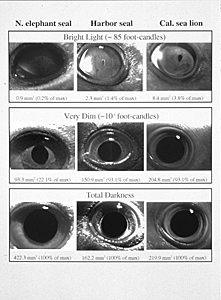![[Currents header graphic]](/homeart/currents_header.gif)
![[Currents header graphic]](/homeart/currents_header.gif)
August 18, 1997

|
|
Photographs of the pupils of a northern elephant seal, harbor seal, and California sea lion
|
Do pinnipeds hear their prey, or do they see them? Schusterman's hypothesis is that it's both, but primarily the latter: Those big watery eyes just soak up photons, even at great depths.
If that's the case, then deeper diving animals should have more sensitive eyesight, since they need to forage at lower levels of light. Graduate student David Levenson has explored that notion over the past few years with a pair of innovative experiments on Rio, Sprouts, and Burnyce. (Rocky, who has age-related cataracts, sat this one out.)
First, Levenson trained the animals to remain still in a darkened room while facing a device that let him control, with precision, the amount of light shining into their eyes. With an infrared camera, he measured the dilation of their pupils at different brightnesses, ranging from ambient light to near darkness.
Burnyce, whose species routinely plummets from the bright ocean's surface to the shadowy depths below, proved the most dark-adaptable of the three. Indeed, her pupils were still constricted--a sign of greater sensitivity--at a light intensity about 100,000 times dimmer than the levels at which Rio's and Sprouts' pupils had become fully dilated. "No one expected that," Levenson said. "It's an unbelievably huge difference."
In the second set of experiments, Levenson zeroed in on the faintest flashes of light that the animals could perceive--a more robust indicator of their visual capacities. He built a light-tight enclosure over a small pool, in which each subject floated while watching for the light. Just as in the hearing tests, a correct response (touching nose to ball when the light flashed) netted a fish. Levenson monitored the animals' actions via a small infrared camera and adjusted the intensity of the flashing light from above the pool with a clever system of filters.
Again, Burnyce detected flashes at far lower levels than her companions. Rio was slightly better than Sprouts, a sensible result because California sea lions forage almost exclusively at night. However, with just one experimental subject for each species, the team can't draw too many broad-based conclusions about their kin in the wild.
"We pretty much understand what pinnipeds do on land, but many of their behaviors in the ocean are a black box," Levenson said. "This provides us with some baseline biological evidence of how their aquatic visual systems might work." Scientists have not yet ruled out that pinnipeds also might echolocate on occasion or use other nonvisual means to listen or feel for prey, Levenson said. However, his results show that for many species, vision probably is the most important sense.
A better grasp of the visual abilities and limitations of various pinnipeds, Schusterman noted, could help inform conservation management plans. Oil spills, nearshore pollution, or sedimentation that increases the opacity of water might cut the animals' odds of finding a meal.